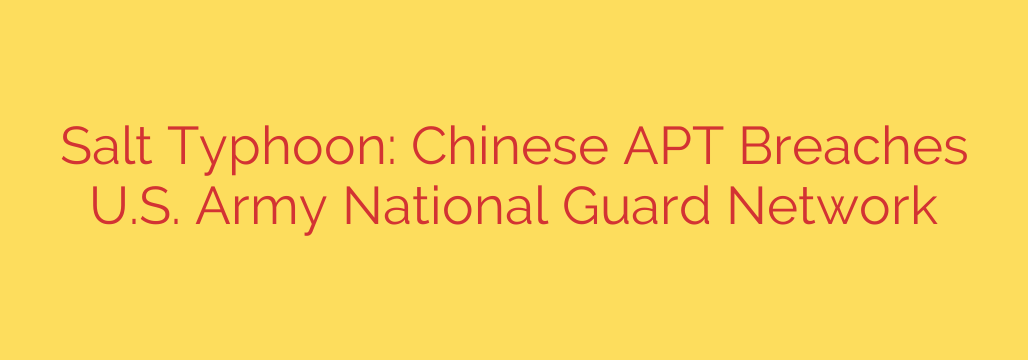
Volt Typhoon Cyberattack: Chinese Hackers Infiltrate U.S. National Guard Network
In a significant and alarming development in cybersecurity, a highly sophisticated Chinese state-sponsored hacking group has successfully breached the network of the U.S. Army National Guard. The group, known as Volt Typhoon (also identified as Salt Typhoon), has demonstrated an advanced ability to infiltrate critical U.S. infrastructure, raising serious national security concerns.
This incident is not a simple smash-and-grab data theft; it represents a calculated effort to establish long-term, persistent access to sensitive government networks. The primary goal appears to be espionage and pre-positioning for future disruptive operations, allowing the attackers to maintain a foothold that could be leveraged during a potential crisis or conflict.
Stealth and Deception: Unpacking the Attack Methods
What sets Volt Typhoon apart is its mastery of stealth. The group meticulously avoids detection by using a technique known as “living-off-the-land” (LOTL). Instead of deploying custom malware that could be easily flagged by security software, these hackers utilize legitimate tools and services already present on the target network.
By leveraging built-in system utilities like PowerShell and Windows Management Instrumentation (WMI), their malicious activities blend in with normal administrative traffic, making them incredibly difficult to identify. This approach allows them to operate undetected for extended periods.
The initial point of entry for these attacks often involves exploiting vulnerabilities in common network edge devices. Volt Typhoon is known to target routers, firewalls, and VPNs from manufacturers like Cisco and Fortinet. After compromising these devices, they establish a hidden network of command-and-control servers, often using hacked small office/home office (SOHO) routers to anonymize their traffic and evade security measures.
Once inside a network, the group moves laterally, seeking to escalate privileges and steal credentials. In the National Guard breach, a key target was a Microsoft Active Directory Federation Services (ADFS) server, which is critical for managing user identity and access. By compromising this server, the attackers could gain widespread access to network resources.
The Strategic Threat to Critical Infrastructure
The targeting of the U.S. National Guard is a clear indicator of the group’s strategic objectives. This is part of a broader campaign by Volt Typhoon that has also targeted organizations in communications, energy, transportation, and water sectors. The intent is clear: to gain deep, persistent access to the systems that underpin national security and daily life.
This long-term access provides invaluable intelligence and serves as a strategic asset. By maintaining a silent presence within these networks, the attackers can exfiltrate sensitive data over time and, more critically, retain the ability to disrupt or disable essential services at a moment’s notice. This represents a persistent and evolving threat to national security.
Protecting Your Network: Key Security Takeaways
The tactics employed by Volt Typhoon highlight the need for a defense-in-depth security posture that goes beyond traditional antivirus solutions. Organizations, especially those in critical sectors, must take immediate steps to harden their defenses.
Here are essential security measures to implement:
- Secure Network Edge Devices: Immediately apply security patches to all routers, firewalls, and VPN concentrators. Change default administrator passwords and disable unnecessary services.
- Harden Identity and Access Management: Vigorously protect systems like ADFS. Enforce strong, unique passwords and mandate the use of multi-factor authentication (MFA) for all users, especially privileged accounts.
- Monitor for “Living-Off-the-Land” Activity: Deploy advanced Endpoint Detection and Response (EDR) tools that can identify anomalous use of legitimate system utilities. Enhance logging and monitoring for PowerShell, WMI, and other administrative tools.
- Implement Network Segmentation: Divide your network into smaller, isolated segments to prevent attackers from moving laterally. If one part of the network is compromised, segmentation can contain the breach and limit the damage.
- Assume a Breach Mindset: Operate under the assumption that an attacker may already be inside your network. Proactively hunt for threats, conduct regular security audits, and have a robust incident response plan ready to execute.
The Volt Typhoon campaign is a stark reminder that sophisticated, state-sponsored cyber threats are a constant reality. Vigilance, proactive defense, and a commitment to security fundamentals are no longer optional—they are essential for protecting our most critical assets.
Source: https://securityaffairs.com/180018/intelligence/salt-typhoon-breach-chinese-apt-compromises-u-s-army-national-guard-network.html








